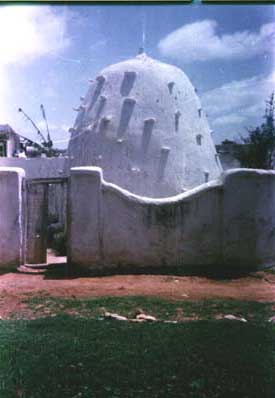|
|
|

HARARI NATIONAL REGIONAL STATE - The
State of Harrari People -

| Harar is one of the most popular historical towns in the eastern part of Ethiopia. The majestic wall that has enveloped the town has high standing in the community. It is a great pleasure to meet the candid, dexterous and hospitable people of Harari. You will be also be greeted like a long lost friend! Moreover the proud women - gorgeously dressed in their traditional costumes - add color to the vibrant atmosphere of the town. The orange and mango trees as well as other varieties of fruits make up the charm of the countryside. Moreover, its closeness to Dire Dawa, a boom town, is also an inspiration to its citizens in their flourishing economic activities. Singers often praise Harar with its tropical fruits and its elegant children in their heart-warming songs. The Harari National Regional state consists of the city of Harar and the surrounding rural areas. Harari region has no administrative zones or woredas. The total number of kebeles of the city of Harar are 19, while the rural parts of the region has 17 farmers' association localities. The capital city of the region is Harar. H.E. Abdulahi Idiris Ibrahim is the President of the Regional State. |  |
City of Harar
Harari lies 51 kilometers to the south east of Dire Dawa. It is located in the eastern wall of the Great Rift Valley looking over the vast Danakil desert to the north, the cattle rich savannas to the south and fertile lands of the Harar mountains to the east. It lies between two rivers, tributaries of the Erer, on the southern edge of a vast plateau. The surrounding mountains divide the Great Rift Valley from the plains of the Ogaden. Ethnic composition and Languages The Harari region is characterized by the following ethnic
groups, Oromo 52.3%, Amhara 32.6%, Harari 7.1%, Guragies 3.2%. The Harari
language is the official language of the regional state.
The origin of the walled city of Harar dates back to before the thirteenth century. The houses of the old city are constructed of stone and plaster, with flat roofs. Hararís strategic location made it an important center of Islamic culture and commerce. With its 99 mosques, Harar is considered to be the fourth most holy city of Islam. The setting of medieval walls tightly embracing the ancient city, its rich and exciting market-place, its towering and majestic mountains, and its bracing cool air make Harar an exciting place to visit. The Rimbaud house, named after the renowned French poet, Arthur Rimabud is also found in the vicinity of the walled city. Background information: FDRE Office of the Government Spokesperson 03/11/98
|
Religions According to the 1994 census result the composition of the population of the Harari region indicates that 60.3% are Muslims, 38.2% are Orthodox Christian, 0.9% Protestants, 0.5% Catholics, and 0.1% followers of other religion groups. The Climate The climate of Harari region is one of the most pleasant
in the country. Temperature is even - between 17.1oc-20.2oc throughout
the year. The coolest season (18.7oc) is between June and September, and
coincides with large rains accompanied by storms and strong electrical
discharges. The average annual intensity of precipitation is about 750-1,000
mm. The mean amount of rain-fall over three year as registered 10 years
ago was 1,509 mm.
|
The Federal
Democratic Republic of Ethiopia Basic Information The State of Harrari
People